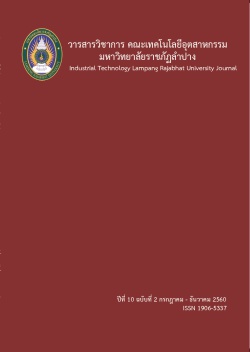การประยุกต์ใช้ชุดอุปกรณ์เติมแก๊สออกซิเจนหัวเผาเวนจูรีในเตาเผาผลิตภัณฑ์เซรามิก
Keywords:
เตาเผา, หัวเผาเวนจูรี, เติมแก๊สออกซิเจน, ประสิทธิภาพการเผา, kiln, venturi burner, oxygen-inlet, firing efficiencyAbstract
การประยุกต์ใช้ชุดอุปกรณ์เติมแก๊สออกซิเจนหัวเผาเวนจูรี มีวัตถุประสงค์เพื่อเพิ่มประสิทธิภาพการเผาของเตาเผาผลิตภัณฑ์เซรามิกชนิดทางเดินลมร้อนลง โดยอาศัยการควบคุมอัตราการไหลของแก๊สออกซิเจนเข้าสู่หัวเผาแบบเวนจูรีด้วยเกจควบคุมแรงดันพร้อมกับเชื้อเพลิงแก๊สปิโตรเลียมเหลว จำนวน 6 ชุด ในเตาเผาขนาด 1 ลูกบาศก์เมตร จากนั้นตรวจสอบประสิทธิภาพการเผา ผลการวิจัยพบว่า ชุดอุปกรณ์เติมแก๊สออกซิเจนหัวเผาเวนจูรี มีประสิทธิภาพการเผาที่อุณหภูมิ 1220 องศาเซลเซียส คือ สามารถเผาได้ทั้งบรรยากาศออกซิเดชันและรีดักชัน ใช้เวลาในการเผา 10 และ 10 ชั่วโมง อัตราการเผา 122 และ 122 องศาเซลเซียสต่อชั่วโมง โดยใช้ปริมาณแก๊สเชื้อเพลิง 25.2 และ 29.6 กิโลกรัม และปริมาณแก๊สออกซิเจน 12.9 และ 9.4 กิโลกรัม ตามลำดับ เมื่อเปรียบเทียบประสิทธิภาพการเผาโดยใช้หัวเผาแบบปกติและการเผาแบบใช้ชุดอุปกรณ์เติมแก๊สออกซิเจนหัวเผาเวนจูรี พบว่า การเผาที่อุณหภูมิ 1220 องศาเซลเซียส บรรยากาศออกซิเดชันใช้เวลาการเผาลดลง 4 ชั่วโมง คิดเป็นร้อยละ 28.57 อัตราการเผาเร็วขึ้น 35 องศาเซลเซียสต่อชั่วโมง คิดเป็นร้อยละ 40.23 และปริมาณแก๊สเชื้อเพลิงที่ใช้ในการเผาลดลง 8.9 กิโลกรัม คิดเป็นร้อยละ 26.10 เมื่อศึกษาต้นทุนและผลตอบแทน พบว่า มีต้นทุนเพิ่มขึ้นจากการปรับปรุงหัวเผา 9,000 บาท จุดคุ้มทุนที่ต้องใช้ชุดอุปกรณ์เติมแก๊สออกซิเจนในการเผาผลิตภัณฑ์ จำนวน 563 ครั้ง มีมูลค่าปัจจุบันสุทธิ 2,417.47 บาท อัตราผลตอบแทนของโครงการ ร้อยละ 19.82 ซึ่งเป็นค่าอัตราผลตอบแทนของโครงการสูงกว่าอัตราดอกเบี้ยที่ใช้ในการคำนวณ ร้อยละ 10 และระยะเวลาคืนทุน 3.86 ปี
Application of Oxygen-inlet Venturi Burner in Ceramic Kilns
The aim of the direct oxygen-inlet Venturi burner is to optimize the firing efficiency of downdraft ceramic kilns by controlling the flow rate of oxygen into the Venturi burner with the amount of 6 units of LPG per 1 cubic meter of kiln space. There follows tests of its firing efficiency. The results found that it fires at 1220 degrees Celsius and that it is able to burn at both oxidation and reduction atmospheres for 10 hours, the firing rate is 122 degrees Celsius/hour, with 25.2 and 29.6 kilograms of spent LPG fuel, and 12.9 and 9.4 kilograms of spent oxygen, respectively.
When comparing the combustion performance of conventional firing against that of direct-oxygen flow equipment at 1220 degrees Celsius within an oxidation atmosphere, it was found that firing time can be reduced by 4 hours or 28.57%, with an increased burn rate of 35 degrees Celsius/hour or 40.23% and a reduction in the consumption of LPG fuel to 8.9 kilograms or 26.10%. When studying the costs and returns, it was found that the cost of upgrading a burner was 9000 Baht. The break-even point is 563 times, with a Net Present Value (NPV) of 2,417.47 Baht, an Internal Rate of Return (IRR) of 19.82% (10 % higher that the interest rate used for the calculation) and a payback period (PBP) of 3.86 years.






